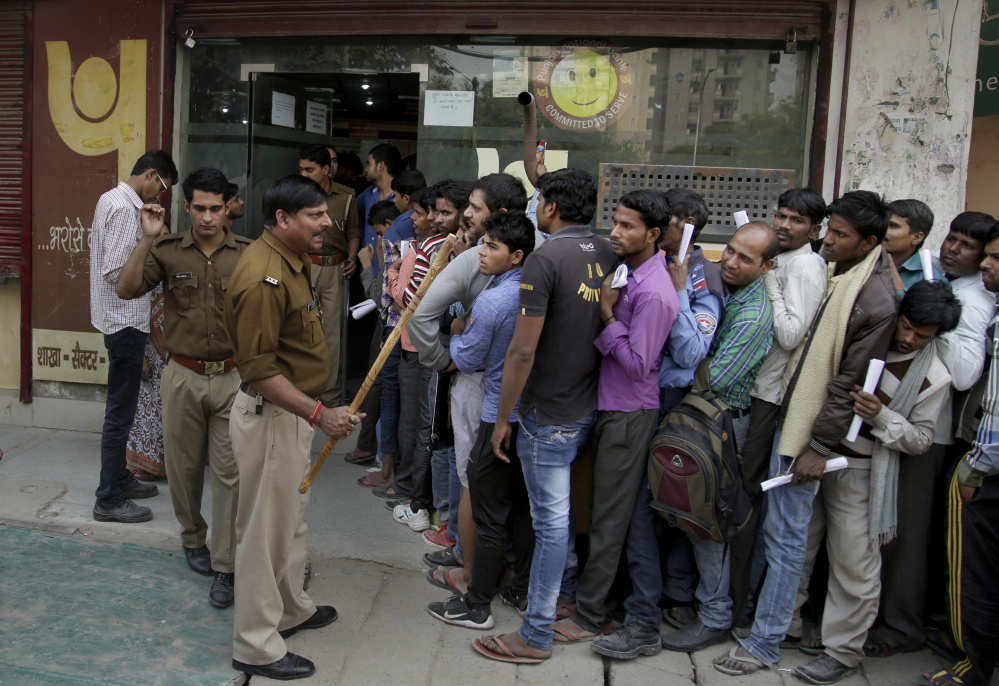NEW DELHI — The sudden withdrawal of 86 percent of India’s currency has left cash in short supply, retail sales stumbling and wholesale markets in turmoil.
That’s just the immediate fallout from Prime Minister Narendra Modi’s surprise effort to stamp out corruption by making cash hoards in large denomination bills worthless. But what lies ahead could be even worse, some analysts say.
“Basically, you’ve created chaos,” said Steve H. Hanke, an applied economist at Johns Hopkins University in Baltimore and a global authority on currency policy. “India is a cash economy. It’s not like Europe or the U.S. where everyone is running around with a credit card.”
“It doesn’t look like this thing was thought through at all,” he said.
Every day or so, soothing assurances about India’s overnight currency reform spill from the offices of top government officials.
“Enough cash is available,” Economic Affairs Secretary Shaktikanta Das said Thursday during a nationally televised press conference, as millions of people waited in hours-long lines. A few days earlier, the finance minister urged patience with what he called “a period of inconvenience.”
But the decision to ban India’s highest denomination bills, 500 rupee and 1,000 rupee notes worth about $7.50 and $15, goes far beyond an inconvenience.
India’s economy has become one of the world’s largest in recent years, but millions of businesses, and hundreds of millions of people, lack bank accounts and use cash to pay for everything from groceries to hospital stays to land purchases.
The shadow economy – transactions hidden from the authorities – is believed to amount to about a quarter of the country’s gross domestic product.
The government used a similar demonetization in the late 1970s. But it failed to curb corruption, and the underground economy has grown immensely larger since then.
Many Indians do use cash transactions to hide their wealth and avoid taxes – less than 3 percent of the population pays income taxes – and the authorities occasionally arrest businesspeople or corrupt officials with currency hoards that can fill trucks. But more people use cash because of habit, poverty or a lack of easy access to banks.
So instead of just aiming squarely at wealthy tax dodgers, the demonetization is also hammering the poor, the working-class and small business people.
Across India, people are waiting in lines that often form hours before banks open and last into the afternoon, though the government has limited most withdrawals and currency exchanges to a maximum of $30 a day.
“It is unclear whether this exercise will achieve any lasting results other than having created a national economic crisis, destroying confidence in the national currency and unleashing tremendous suffering for ordinary Indian citizens,” said Rajiv Biswas, Asia-Pacific chief economist at HIS Global Insight. “This will have a direct negative effect on retail sales and industrial output during the coming weeks.”
A research report last week from the banking giant HSBC predicted that imports of consumer goods would fall, but added that could be offset by a spike in demand for gold, as unsettled Indians look for ways to store their wealth.
In worst-case scenarios, the effects of demonetization could last for years, driving the country into recession and pushing Indians to keep their wealth in more stable currencies, such as the euro or U.S. dollar.
“When you don’t trust a currency and you don’t trust a government you start using foreign currencies,” said Hanke.
Raghuram Rajan, the former head of India’s central bank, warned in 2014 that demonetization programs can stumble.
“It’s not that easy to flush out black money,” he had said. “My sense is that the clever find ways” to get around currency overhauls.
Rajan has suggested better monitoring of financial transactions, such as using government ID cards to track purchases, and improved tax enforcement.
Send questions/comments to the editors.



Success. Please wait for the page to reload. If the page does not reload within 5 seconds, please refresh the page.
Enter your email and password to access comments.
Hi, to comment on stories you must . This profile is in addition to your subscription and website login.
Already have a commenting profile? .
Invalid username/password.
Please check your email to confirm and complete your registration.
Only subscribers are eligible to post comments. Please subscribe or login first for digital access. Here’s why.
Use the form below to reset your password. When you've submitted your account email, we will send an email with a reset code.